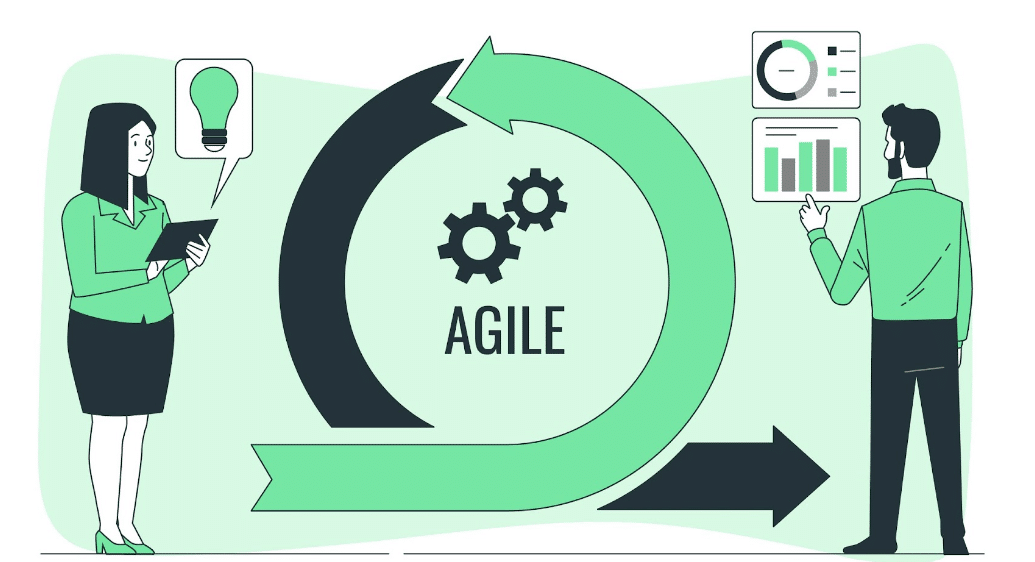While the idea of integrating seemingly two different things—agile development and public relations—might sound completely weird, it can yield phenomenal results for organizations.
Both agile development and PR share a common principle: a customer-centric focus. Agile development methodologies prioritize delivering value to customers through iterative development and frequent feedback loops. Similarly, PR aims to create positive experiences among customers and stakeholders.
By aligning these two disciplines, businesses can ensure that their products or services meet customer needs while effectively communicating their value to the target audience.

Understanding agile development
Agile has become the new buzzword that’s been used in business quite a lot. However, despite its widespread use, there’s still a need for a deeper understanding of what agile development truly entails.
At its core, agile development is an iterative and collaborative approach that emphasizes flexibility, adaptability, and continuous improvement. Unlike traditional waterfall methodologies, where projects follow a linear sequence of predefined stages, agile embraces change and focuses on delivering incremental value to customers throughout the development process.
According to a report by VersionOne, 94 percent of organizations surveyed are practicing Agile or using its techniques. What makes this approach so popular is that it allows teams to break down complex projects into manageable tasks and promote cross-functional collaboration, while leaving them wiggle room to embrace a change quickly when needed.
The role of public relations
PR is the strategic management of communication between organizations and their stakeholders. The goal of PR is to build and maintain a positive brand reputation, manage media relations, crisis communication, and engage with customers and the public.
Effective PR is crucial for establishing trust, enhancing brand perception, and navigating challenging situations. The Global Communications Report by the USC Annenberg Center for PR revealed that 87 percent of PR professionals believe that the industry’s future success relies on integrating traditional and digital communication strategies.

Challenges in traditional development and PR approaches
Traditional waterfall development methodologies and linear PR approaches often encounter limitations that impede their effectiveness.
Waterfall development, with its sequential and rigid nature, struggles to adapt to the dynamic market and evolving requirements. On the other hand, traditional PR practices can be sluggish, reactive, and lack integration with other departments.
All this makes it difficult for companies to keep up with the customer’s ever-evolving needs, which drastically slows down the business growth, if not makes it impossible.
To overcome these challenges and stay ahead in the Canadian market, businesses can embrace agile development methodologies and leverage innovative PR strategies that integrate seamlessly with digital platforms, providing customers with convenient options to buy Ethereum in Canada and ensuring continuous adaptation to their evolving demands.
7 benefits of synergies between agile development and PR
The synergy between agile development and PR is the secret sauce to success. It’s the missing piece that connects the dots, transforms missed opportunities into triumphs, and propels your organization forward.
By implementing an agile approach in PR project strategy, companies can enjoy a variety of benefits. Let’s explore some of the most important of them.
1) Ability to adapt quickly to changes
The PR landscape is dynamic, with rapidly changing market conditions, emerging trends, and rising stakeholder expectations. That’s where an agile approach comes into play. It allows teams to be flexible and adapt to these changes in real time so they can stay ahead of the flock.
When implementing agile methodologies in PR, organizations can further enhance their capabilities by leveraging nearshore development services, which provide access to a talented pool of skilled professionals in close geographical proximity. This collaboration enables seamless communication, efficient project management, and streamlined development processes.
2) Faster response time
In today’s fast-paced digital age, speed is of the essence. If you are not the first, then you risk being left behind, which is especially true in the realm of PR, where timely and proactive communication is crucial for success.
However, with agile, PR teams can break down projects into smaller, manageable tasks and set shorter timeframes for delivery. This allows for faster decision-making and execution, ensuring that PRs are able to respond swiftly to media inquiries, customer feedback, and other relevant developments.
Additionally, leveraging mobile app development services can further enhance the speed and responsiveness of PR teams, enabling them to quickly adapt and engage with their target audience through user-friendly and intuitive mobile applications.
3) Iterative improvement
One of the biggest advantages of adopting agile is its emphasis on continuous improvement through iterative cycles. This powerful concept allows PRs to fine-tune their campaigns, gain valuable insights from each iteration, and maintain a competitive edge in the ever-evolving landscape of PR.
4) Enhanced collaboration within teams
Furthermore, agile fosters collaboration within teams and across departments. By working in cross-functional teams, PRs can collaborate closely with stakeholders, including marketing, product development, and executive teams, and ensure that their strategies are aligned with overall business goals.
It should also be noted that communication within teams is transparent and doesn’t require management. Everyone knows what they need to focus on to keep the project going and speaks up during short daily meetings, rather than hiding behind someone’s back.
To further support effective collaboration and streamline development processes, companies can hire Django developers who are skilled in utilizing this powerful web framework, allowing teams to leverage its robust features and functionalities for building scalable and efficient web applications that align seamlessly with their PR strategies and business objectives.
5) Stakeholder engagement
Effective PR involves engaging and building relationships with various stakeholders, including media, customers, influencers, and the public. Agile enables teams to engage stakeholders in a more targeted and personalized manner.
By collecting feedback, analyzing data, and adapting strategies, they can gain actionable insights into how communication can be improved and what’s needed to strengthen relationships and drive positive brand perception.
6) Measurable results
What is also distinct about agile methodologies is that they emphasize metrics and data-driven decision-making (DDDM). By setting clear objectives, defining KPIs, and regularly tracking progress, PR teams can measure the impact of their initiatives.
As a result, they can make better decisions, optimize their resources, and demonstrate the value and ROI of PR efforts to stakeholders.
Data-driven decision-making plays a crucial role in agile methodologies for PR teams, enabling them to leverage actionable insights and analytics to inform their strategies, refine their approaches, and drive continuous improvement in their campaigns, ultimately leading to more impactful results and greater alignment with organizational goals.
7) Efficient resource allocation
Last but not least, the advantage of agile is that it enables companies to allocate their resources more effectively based on their impact and value. Instead of strictly following a predetermined strategy that may not have been successful from the start, they can continuously reprioritize and ensure that available resources are used to the best advantage.
To ensure efficient resource allocation, it is crucial for companies to define KPIs that align with their business objectives and track the progress and impact of their initiatives, enabling informed decision-making and optimizing resource allocation for maximum effectiveness and ROI.

Starting your agile PR campaign strategy
Starting your agile PR campaign strategy requires a solid grasp of its key elements and the integration of agile practices. By following a strategic approach, you can set the foundation for a successful PR campaign that embraces agility and delivers impactful results.
Here are the key steps to consider when launching your agile PR campaign:
- Define clear objectives. What do you want to achieve? Is it increasing brand awareness, driving traffic, or generating leads? Whatever the case, make sure that you set specific, measurable, achievable, relevant, and time-bound (SMART) objectives.
- Conduct audience research. Understand who your public is, where they live, how they behave, and what motivates them. With this info at hand, it will be easier to tailor your messaging so that it resonates with your audience.
- Build cross-functional teams. Foster agile practices on the team, ensuring that everyone understands them and stays aligned with the campaign’s objectives.
- Conduct agile planning. Adopt agile methodologies such as Scrum or Kanban to plan your campaign. Break down the campaign into smaller tasks, prioritize them based on their importance, and assign them to team members with set deadlines.
- Embrace sprints. Divide your campaign timeline into sprints. During each sprint, focus on completing the prioritized tasks while ensuring effective communication and collaboration within the team.
- Daily stand-up meetings. Reorganize your working day, ensuring that you have at least 15 minutes each day to hold brief meetings with your team to discuss progress. These meetings replace complex documentation while allowing everyone to stay on track.
- Monitor and evaluate progress. Once you’ve started, keep a close eye on the KPIs. Gather feedback from your stakeholders, analyze data, and use those insights to optimize your strategies during the next iteration. To streamline this process and make it more efficient, consider leveraging performance management software.
- Foster iterative improvement. The desire to improve should be at the core of everything you and your team do. Encourage your colleagues to share their ideas and observations learned from each sprint and act on them to achieve better outcomes.
- Adapt and pivot. Watch for the latest trends in PR and competitor activities to be the first to capitalize on changing circumstances. It’s like buying cryptocurrency: you need to always be alert, use different solutions such as Coindataflow and others to monitor changes in the market to make timely decisions and succeed. It works the same way when running an Agile PR campaign.
- Create a learning culture. Improvement is only possible through learning, so it’s essential that all people on the team are willing to learn. Celebrate successes, learn from failures, and promote knowledge sharing during your daily meetings.
To further enhance your agile PR campaign, you can also leverage powerful integrated development environments like the dbt IDE.
The dbt IDE provides advanced features and functionalities designed to streamline data analysis and management processes, making it a valuable tool for optimizing your PR strategies.
Future directions and emerging trends
The collaboration between agile development and PR is an exciting and evolving field with promising prospects. Agile PR, which combines the flexibility of development methodologies with the strategic approach of PR, is paving the way for faster responses, DDDM, and real-time stakeholder engagement.
This innovative approach tailors frameworks specifically for PR professionals and marketers, enabling them to adapt quickly and engage effectively with their target audience. Moreover, implementing an agile software development life cycle can facilitate seamless collaboration between development, PR, and marketing teams.
The integration of AI and automation with agile development and PR is also on the horizon. AI-powered analytics tools can provide valuable insights into consumer behavior, sentiment analysis, and media monitoring, enabling PR teams to polish their communication strategies.
Furthermore, the rise of social media and digital platforms presents new opportunities and challenges for agile and PR integration. Companies need to leverage agile to adapt to and respond to the rapidly changing social media landscape, engage with online communities, and manage their reputation effectively in the digital age.
Final words
To sum it up, going agile for PR companies is not so much an option as it is a necessity given today’s dynamic business environment. Companies need to leverage the methodologies of agile to be able to adapt and respond to changes. It is also the only surefire way to stand out from the competitors and be the first to come up with a message that truly appeals to the public.
You don’t need to hit hard on it from the get-go if this is something completely new to you. Start small and you’d be surprised how naturally it will all work out, bringing the results you couldn’t even have imagined!








